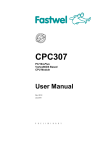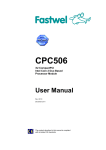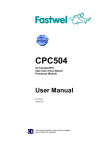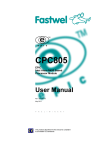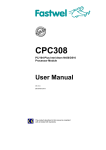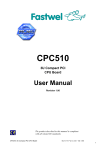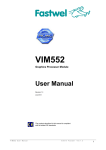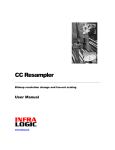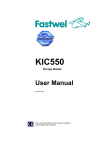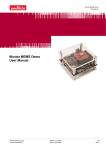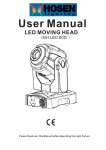Download CPC508 User Manual
Transcript
CPC508 3U CompactPCI CPU Module User Manual Rev. 001 E December 2012 The product described in this manual is compliant with all related CE standards. Product Title: Document name: Manual version: Ref. docs: CPC508 CPC508 User Manual 001 E CPC508-UM-v1.02-R (IMES.467444.062 RE) Copyright © 2012 Fastwel Co. Ltd. All rights reserved. Revision Record Rev. Index Brief Description Product Index Date 001 Initial version CPC508, MIC589 December 2012 Contact Information Fastwel Co. Ltd Fastwel Corporation US Address: 108 Profsoyuznaya st., Moscow 117437, Russian Federation 45 Main Street, Suite 319 Brooklyn, New York 11201 USA Tel.: +7 (495) 232-1681 +1 (718) 554-3686 Fax: +7 (495) 232-1654 +1 (718) 797-0600 Toll free: E-mail: [email protected] Web: http://www.fastwel.com/ +1 (877) 787-8443 (1-877-RURUGGED) CPC508 Table of Contents Table of Contents ..............................................................................................................................................1 List of Tables .....................................................................................................................................................2 List of Figures ....................................................................................................................................................3 Notation Conventions.........................................................................................................................................4 General Safety Precautions................................................................................................................................5 Unpacking, Inspection and Handling...................................................................................................................6 Three Year Warranty..........................................................................................................................................7 1 Introduction...................................................................................................................................... 8 1.1 1.2 1.3 1.4 1.5 1.6 2 Functional Description ...................................................................................................................14 2.1 2.2 3 3.5 Safety Regulations ................................................................................................................................24 Installation Procedure............................................................................................................................25 Removal Procedure...............................................................................................................................25 Peripheral Devices Installation...............................................................................................................26 3.4.1 CompactFlash Cards Installation ...........................................................................................26 3.4.2 USB Devices Installation .......................................................................................................26 3.4.3 Battery Replacement.............................................................................................................26 Installation of MIC589 Mezzanine Expansion Module .............................................................................27 Configuration and Programming....................................................................................................28 4.1 4.2 5 Module Interfaces..................................................................................................................................14 2.1.1 CompactPCI Bus Connectors................................................................................................14 2.1.1.1 CompactPCI Connector Color Coding....................................................................14 2.1.1.2 CompactPCI Connectors J1 and J2 Pinouts...........................................................15 2.1.2 Connector for Mezzanine Module ..........................................................................................17 2.1.3 Keyboard/Mouse Interface ....................................................................................................18 2.1.4 USB Interfaces......................................................................................................................18 2.1.5 Graphics Controller ...............................................................................................................19 2.1.5.1 VGA Interface and Connector................................................................................19 2.1.5.2 LVDS Interface .....................................................................................................19 2.1.6 Serial Interfaces (RS232 and RS422/485)..............................................................................20 2.1.7 Gigabit Ethernet....................................................................................................................20 2.1.8 SATA Ports...........................................................................................................................21 2.1.9 HD Audio..............................................................................................................................21 2.1.10 CompactFlash Socket ...........................................................................................................21 2.1.11 LED Indicators L1 and L2......................................................................................................22 Data Storage Subsystem for CPC508 ....................................................................................................23 Installation.......................................................................................................................................24 3.1 3.2 3.3 3.4 4 Overview ................................................................................................................................................8 Technical Characteristics.........................................................................................................................8 CPC508 Versions..................................................................................................................................10 Delivery Checklist..................................................................................................................................11 CPC508 Diagrams ................................................................................................................................11 1.5.1 Block Diagram ......................................................................................................................12 1.5.2 Module Dimensions and Layout.............................................................................................13 System Expansion Module ....................................................................................................................13 WDT Operation .....................................................................................................................................28 L1 User LED Control .............................................................................................................................28 Phoenix® BIOS Setup .....................................................................................................................29 5.1 5.2 CP C5 0 8 Starting BIOS Setup..............................................................................................................................29 Main Menu............................................................................................................................................30 Us e r M a n u a l 1 © 2 0 1 2 F a s t w e l V e r . 0 0 1 E CPC508 5.3 5.4 5.5 5.6 5.7 5.8 6 Additional Information ....................................................................................................................40 6.1 7 7.3 7.4 7.5 Introduction...........................................................................................................................................41 MIC589 Diagrams .................................................................................................................................41 7.2.1 MIC589 Block Diagram .........................................................................................................41 7.2.2 MIC589 Connectors Layout ...................................................................................................42 7.2.3 MIC589 Components Layout .................................................................................................43 Specifications........................................................................................................................................44 MIC589 Delivery Checklist.....................................................................................................................45 MIC589 Interfaces.................................................................................................................................45 7.5.1 MIC589 Interfaces List ..........................................................................................................45 7.5.1.1 Front Panel (4HP) Interfaces .................................................................................45 7.5.1.2 Interfaces Routed to CPCI J2 Connector ...............................................................45 Supplementary Information............................................................................................................46 8.1 9 System Power.......................................................................................................................................40 MIC589 Mezzanine Expansion Module...........................................................................................41 7.1 7.2 8 5.2.1 IDE Primary/Master...............................................................................................................31 5.2.2 SATA Port 1 – Port 3.............................................................................................................32 5.2.3 Memory Cache .....................................................................................................................32 5.2.4 Boot Features .......................................................................................................................33 Advanced Menu ....................................................................................................................................33 5.3.1 PnP Configuration Submenu .................................................................................................34 Intel Menu.............................................................................................................................................34 5.4.1 CPU Control Submenu..........................................................................................................35 5.4.2 Video (Intel IGD) Control Submenu........................................................................................35 5.4.3 ICH Control Submenu ...........................................................................................................36 5.4.3.1 PCI Express Control Submenu..............................................................................36 5.4.3.2 ICH USB Control Submenu ...................................................................................37 Security Menu.......................................................................................................................................37 Boot Menu ............................................................................................................................................38 Custom Menu .......................................................................................................................................38 5.7.1 MIC589 Peripheral ................................................................................................................39 Exit Menu .............................................................................................................................................39 Related Standards and Specifications....................................................................................................46 Useful Abbreviations, Acronyms and Short-cuts............................................................................47 List of Tables Table 2-1: Table 2-2: Table 2-3: Table 2-4: Table 2-5: Table 2-6: Table 2-7: Table 2-8: Table 6-1: Table 9-1: Table 9-2: CP C5 0 8 CompactPCI Connector Coding Colors .......................................................................................14 CompactPCI Bus Connector J1 (XS8) System Slot Pinout ...........................................................15 32-bit CompactPCI Bus Connector J2 (XS7) System Slot Pinout..................................................16 Pinout of XS6 Connector for MIC589 Mezzanine Module.............................................................17 USB1 and USB2 Pinouts (CPC508 Front Panel)..........................................................................18 VGA (XS1) Front Panel Connector Pinout ...................................................................................19 Gigabit Ethernet Connectors Pinouts...........................................................................................20 L1 and L2 LEDs Functions..........................................................................................................22 DC Input Voltage Ranges and Limits...........................................................................................40 Related Standards......................................................................................................................46 Related Specifications ................................................................................................................46 Us e r M a n u a l 2 © 2 0 1 2 F a s t w e l V e r . 0 0 1 E CPC508 List of Figures Figure 1-1: Figure 1-2: Figure 2-1: Figure 2-2: Figure 2-3: Figure 2-4: Figure 2-5: Figure 2-6: Figure 2-7: Figure 5-1: Figure 5-2: Figure 5-3: Figure 5-4: Figure 5-5: Figure 5-6: Figure 5-7: Figure 5-8: Figure 5-9: Figure 5-10: Figure 5-11: Figure 5-12: Figure 5-13: Figure 5-14: Figure 5-15: Figure 5-16: Figure 5-17: Figure 7-1: Figure 7-2: Figure 7-3: CPC508 Block Diagram..............................................................................................................12 CPC508 Module Dimensions and Layout ....................................................................................13 CompactPCI Connectors J1 and J2 à ........................................................................................14 XS6 Expansion Connector for MIC589 Mezzanine Module...........................................................17 USB1 (XS2) and USB2 (XS3) Sockets ........................................................................................18 VGA (XS1) Front Panel Connector..............................................................................................19 Ethernet Connectors...................................................................................................................20 CompactFlash Socket.................................................................................................................21 Data Storage Subsystem ............................................................................................................23 POST Screen Image ..................................................................................................................29 Main Menu Screen .....................................................................................................................30 IDE Primary/Master Screen ........................................................................................................31 Memory Cache Screen ...............................................................................................................32 Boot Features ............................................................................................................................33 Advanced Menu Screen..............................................................................................................33 PnP Configuration Submenu Screen ...........................................................................................34 Intel Menu Screen ......................................................................................................................34 CPU Control Submenu Screen ...................................................................................................35 Video (Intel IGD) Control Submenu Screen .................................................................................35 ICH Control Sub-Menu Screen....................................................................................................36 PCI Express Control Submenu Screen........................................................................................36 ICH USB Control Submenu Screen .............................................................................................37 Security Menu Screen ................................................................................................................37 Boot Menu Screen......................................................................................................................38 Custom Menu Screen .................................................................................................................38 Exit Menu Screen .......................................................................................................................39 MIC589 Block Diagram...............................................................................................................41 MIC589 Connectors Layout ........................................................................................................42 MIC589 Components Layout and Dimensions (Top) ....................................................................43 All information in this document is provided for reference only, with no warranty of its suitability for any specific purpose. This information has been thoroughly checked and is believed to be entirely reliable and consistent with the product that it describes. However, Fastwel accepts no responsibility for inaccuracies, omissions or their consequences, as well as liability arising from the use or application of any product or example described in this document. Fastwel Co. Ltd. reserves the right to change, modify, and improve this document or the products described in it, at Fastwel's discretion without further notice. Software described in this document is provided on an “as is” basis without warranty. Fastwel assumes no liability for consequential or incidental damages originated by the use of this software. This document contains information, which is property of Fastwel Co. Ltd. It is not allowed to reproduce it or transmit by any means, to translate the document or to convert it to any electronic form in full or in parts without antecedent written approval of Fastwel Co. Ltd. or one of its officially authorized agents. Fastwel and Fastwel logo are trademarks owned by Fastwel Co. Ltd., Moscow, Russian Federation. CompactPCI is a trademark of the PCI industrial Computers Manufacturers Group. Ethernet is a registered trademark of Xerox Corporation. IEEE is a registered trademark of the Institute of Electrical and Electronics Engineers Inc. Intel is a trademark of Intel Corporation. Pentium M and Celeron M are trademarks of Intel Corporation. Microsoft is a trademark of the Microsoft corporation. In addition, this document may include names, company logos and trademarks, which are registered trademarks and, therefore, are property of their respective owners. Fastwel welcomes suggestions, remarks and proposals regarding the form and the content of this Manual. CP C5 0 8 Us e r M a n u a l 3 © 2 0 1 2 F a s t w e l V e r . 0 0 1 E CPC508 Notation Conventions Warning, ESD Sensitive Device! This symbol draws your attention to the information related to electro static sensitivity of your product and its components. To keep product safety and operability it is necessary to handle it with care and follow the ESD safety directions. Warning! This sign marks warnings about hot surfaces. The surface of the heatsink and some components can get very hot during operation. Take due care when handling, avoid touching hot surfaces! Caution: Electric Shock! This symbol warns about danger of electrical shock (> 60 V) when touching products or parts of them. Failure to observe the indicated precautions and directions may expose your life to danger and may lead to damage to your product. Warning! Information marked by this symbol is essential for human and equipment safety. Read this information attentively, be watchful. Note... This symbol and title marks important information to be read attentively for your own benefit. CP C5 0 8 Us e r M a n u a l 4 © 2 0 1 2 F a s t w e l V e r . 0 0 1 E CPC508 General Safety Precautions This product was developed for fault-free operation. Its design provides conformance to all related safety requirements. However, the life of this product can be seriously shortened by improper handling and incorrect operation. That is why it is necessary to follow general safety and operational instructions below. Warning! All operations on this device must be carried out by sufficiently skilled personnel only. Warning! When handling this product, special care must be taken not to hit the heatsink (if installed) against another rigid object. Also, be careful not to drop the product, since this may cause damage to the heatsink, CPU or other sensitive components as well. Please, keep in mind that any physical damage to this product is not covered under warranty. Note: This product is guaranteed to operate within the published temperature ranges and relevant conditions. However, prolonged operation near the maximum temperature is not recommended by Fastwel or by electronic chip manufacturers due to thermal stress related failure mechanisms. These mechanisms are common to all silicon devices, they can reduce the MTBF of the product by increasing the failure probability. Prolonged operation at the lower limits of the temperature ranges has no limitations. Caution, Electric Shock! Before installing this product into a system and before installing other devices on it, always ensure that your mains power is switched off. Always disconnect external power supply cables during all handling and maintenance operations with this module to avoid serious danger of electrical shock. CP C5 0 8 Us e r M a n u a l 5 © 2 0 1 2 F a s t w e l V e r . 0 0 1 E CPC508 Unpacking, Inspection and Handling Please read the manual carefully before unpacking the module or mounting the device into your system. Keep in mind the following: ESD Sensitive Device! Electronic modules and their components are sensitive to static electricity. Even a non-perceptible by human being static discharge can be sufficient to destroy or degrade a component's operation! Therefore, all handling operations and inspections of this product must be performed with due care, in order to keep product integrity and operability: n Preferably, unpack or pack this product only at EOS/ESD safe workplaces. Otherwise, it is important to be electrically discharged before touching the product. This can be done by touching a metal part of your system case with your hand or tool. It is particularly important to observe anti-static precautions when setting jumpers or replacing components. n If the product contains batteries for RTC or memory back-up, ensure that the module is not placed on conductive surfaces, including anti-static mats or sponges. This can cause shortcircuit and result in damage to the battery and other components. Store this product in its protective packaging while it is not used for operational purposes. n Unpacking The product is carefully packed in an antistatic bag and in a carton box to protect it against possible damage and harmful influence during shipping. Unpack the product indoors only at a temperature not less than +15°C and relative humidity not more than 70%. Please note, that if the product was exposed to the temperatures below 0°С for a long time, it is necessary to keep it at normal conditions for at least 24 hours before unpacking. Do not keep the product close to a heat source. Following ESD precautions, carefully take the product out of the shipping carton box. Proper handling of the product is critical to ensure correct operation and long-term reliability. When unpacking the product, and whenever handling it thereafter, be sure to hold the module preferably by the front panel, card edges or ejector handles. Avoid touching the components and connectors. Retain all original packaging at least until the warranty period is over. You may need it for shipments or for storage of the product. Initial Inspection Although the product is carefully packaged, it is still possible that shipping damages may occur. Careful inspection of the shipping carton can reveal evidence of damage or rough handling. Should you notice that the package is damaged, please notify the shipping service and the manufacturer as soon as possible. Retain the damaged packing material for inspection. After unpacking the product, you should inspect it for visible damage that could have occurred during shipping or unpacking. If damage is observed (usually in the form of bent component leads or loose socketed components), contact Fastwel's official distributor from which you have purchased the product for additional instructions. Depending on the severity of the damage, the product may even need to be returned to the factory for repair. DO NOT apply power to the product if it has visible damage. Doing so may cause further, possibly irreparable damage, as well as result in a fire or electric shock hazard. If the product contains socketed components, they should be inspected to make sure they are seated fully in their sockets. CP C5 0 8 Us e r M a n u a l 6 © 2 0 1 2 F a s t w e l V e r . 0 0 1 E CPC508 Handling In performing all necessary installation and application operations, please follow only the instructions supplied by the present manual. In order to keep Fastwel’s warranty, you must not change or modify this product in any way, other than specifically approved by Fastwel or described in this manual. Technical characteristics of the systems in which this product is installed, such as operating temperature ranges and power supply parameters, should conform to the requirements stated by this document. Retain all the original packaging, you will need it to pack the product for shipping in warranty cases or for safe storage. Please, pack the product for transportation in the way it was packed by the supplier. When handling the product, please, remember that the module, its components and connectors require delicate care. Always keep in mind the ESD sensitivity of the product. Three Year Warranty Fastwel Co. Ltd. (Fastwel), warrants that its standard hardware products will be free from defects in materials and workmanship under normal use and service for the currently established warranty period. Fastwel’s only responsibility under this warranty is, at its option, to replace or repair any defective component part of such products free of charge. Fastwel neither assumes nor authorizes any other liability in connection with the sale, installation or use of its products. Fastwel shall have no liability for direct or consequential damages of any kind arising out of sale, delay in delivery, installation, or use of its products. If a product should fail through Fastwel's fault during the warranty period, it will be repaired free of charge. For out of warranty repairs, the customer will be invoiced for repair charges at current standard labor and materials rates. Warranty period for Fastwel products is 36 months since the date of purchase. The warranty set forth above does not extend to and shall not apply to: 1. Products, including software, which have been repaired or altered by other than Fastwel personnel, unless Buyer has properly altered or repaired the products in accordance with procedures previously approved in writing by Fastwel. 2. Products, which have been subject to power, supply reversal, misuse, neglect, accident, or improper installation. Returning a product for repair 1. Apply to Fastwel company or to any of the Fastwel's official representatives for the Product Return Authorization. 2. Attach a failure inspection report with a product to be returned in the form, accepted by customer, with a description of the failure circumstances and symptoms. 3. Carefully package the product in the antistatic bag, in which the product had been supplied. Failure to package in antistatic material will VOID all warranties. Then package the product in a safe container for shipping. 4. The customer pays for shipping the product to Fastwel or to an official Fastwel representative or dealer. CP C5 0 8 Us e r M a n u a l 7 © 2 0 1 2 F a s t w e l V e r . 0 0 1 E Introduction CPC508 1 Introduction 1.1 Overview The product described in this Manual is CPC508 – a 3U CompactPCI PlusIO (PICMG 2.30) CPU module. For high-speed data exchange CPC508 employs 32-bit PCI bus together with two Gigabit Ethernet channels, four x1 PCI Express lanes, DVI and eight USB 2.0 channels . Modular design allows flexible system configuration, thus providing optimum price to performance ratio. To expand the functionality of CPC508, the MIC589 mezzanine interface expansion module is used. The operational stability of CPC508 make it perfect for use in industrial applications. 1.2 Technical Characteristics n n n n n CP C5 0 8 Intel® processors: Low power Atom core, integrated memory and graphics controllers § Intel Pineview-M, single core (N450, for CPC508-01) § Intel Pineview-D, dual core (D510, for CPC508-03) § IA 32-bit & 64-bit technology; § Intel SIMD2 & 3 (SSE2 + SSE3 + SSSE3); § Hyperthreading Technology (2 threads); § Level 1 cache memory (32 KB instructions, 24 KB data); § Level 2 cache memory: 512 KB (N450), 1 MB (D510); § Intel SpeedStep Technology Intel chipset: ICH8M System memory: § DDR2 SDRAM 667 MHz w/o ECC § 1 GB, soldered, 64-bit addressing Integrated high performance graphics controller: § VGA front panel connector, CRT displays support with resolutions of up to 1400x1050 60 Hz for N450 and up to 2048×1536 60 Hz for D510; § LVDS interface (resolutions up to 1280x800 60 Hz for N450 and 1366x768 60 Hz for D510, single channel, 18-bit), routed to mezzanine connector, available via MIC589 module PCI bus: § Routed to CPCI J1 connector § Spec. v.2.3 support § 32-bit / 33 MHz § Support for up to 7 bus master devices Us e r M a n u a l 8 © 2 0 1 2 F a s t w e l V e r . 0 0 1 E Introduction n n n n n n n n n n n n n n CP C5 0 8 CPC508 LPC bus: § Routed to mezzanine connector § Spec. v1.0 compatibility § Support for two Master/DMA devices PCI Express: four x1 lanes § Routed to CPCI J2 connector § Spec 1.1 compatibility § Support for up to four x1 devices (up to 2.5 Gbit/s) Flash BIOS: § SPI interface, 16 Mbit § In-system modification NAND flash disk: § 4 GB NAND flash, dual channel, soldered § SATA interface (50 MB/s read, 45 MB/s write) § Can be used as boot device CompactFlash Type II socket: § Support for PIO & UDMA modes § UltraATA 100/66/33 SATA interface: § Up to 300 MB/s § Two ports § Routed to CPCI J2 connector Gigabit Ethernet interfaces: § Two PCI-E controllers § 10/100/1000 Mbps § Two RJ-45 frontpanel connectors § Front/rear switchable USB: § 1.1 and 2.0 support, § Up to 8 devices: two at CPC508 front panel, two via MIC589 (mezzanine connector), four via CPCI J2 available at the backplane FRAM: § Available via SMBus § 64 Kbit, 256 B RAM for BIOS Setup parameters storage Real-time clock § Integrated in ICH8M § CR2032 battery backup (3V) Audio § Discrete HD audio § Routed to mezzanine connector Watchdog timer: § Fixed timeout period (1.6 s) § Reset source Hardware monitor § Available via SMBus § Power voltages monitoring § CPU and PCB temperatures monitoring Front panel LED indicators § Disk drives activity LED § Programmable user LED Us e r M a n u a l 9 © 2 0 1 2 F a s t w e l V e r . 0 0 1 E Introduction n CPC508 Mezzanine connector: § Used for connection of MIC589 interface expansion module § HD Audio, two USB ports, LVDS, 8-bit local bus Weight: 0.450 kg max Dimensions: 130.5 mm × 213.0 mm х 20.32 mm Power voltage: +5 V ± 5% from CPCI connector Consumption current: § CPC508-01: 2.8 A § CPC508-03: 3.1 A MTBF: 140000 hours OS compatibility: § FreeDOS § Windows XP (Embedded) § Linux 2.6 § QNX 6.5 n n n n n n 1.3 CPC508 Versions CPC508 is available in two versions: 1 – 1 2 – 3 \ 4 Basic product name: CPC508 2 3 Version: Version CPU 01 Intel Pineview-M (N450) 03 Intel Pineview-D (D510) Operating temperature range: I 4 Industrial, -40°C … +85°C Other options: Coating \COATED Protective coating Operating System \XPE \LNX CP C5 0 8 Us e r M a n u a l Windows XP Embedded Linux 2.6 10 © 2 0 1 2 F a s t w e l V e r . 0 0 1 E Introduction 1.4 CPC508 Delivery Checklist The CPC508 delivery set includes: 1. 2. 3. 4. CPC508 processor module MIC 23008 CompactFlash memory module with preinstalled Windows XPe (only if \XPE option is selected) Antistatic bag Consumer carton box (~ 230×155×45 mm, gross weight 0.650 kg max) Note: Keep the antistatic bag and the original package at least until the warranty period is over. It can be used for future storage or warranty shipments. 1.5 CPC508 Diagrams The diagrams in this section give visual information about the CPC508 module design, connectors and components layout. The diagrams may not reflect insignificant differences between the CPC508 versions. 6 CP C5 0 8 Us e r M a n u a l 11 © 2 0 1 2 F a s t w e l V e r . 0 0 1 E Introduction 1.5.1 CPC508 Block Diagram Figure 1-1: CPC508 Block Diagram Soldered NAND Flash 4 GB Soldered DDR2 SDRAM 1 GB XS1 SATA NAND Flash Controller PineView-M VGA CRT Gigabit Ethernet i82574 XS4 XS2 XS3 Gigabit LAN 1, 2 Gigabit Ethernet Multiplexor USB 1 Gigabit Ethernet i82574 IDE Compact Flash SATA SATA Ports 1-2 x4 DMI XP5 Gigabit LAN 1 Gigabit LAN 2 PCIE PCIE PCIE USB 2 XS7(J2) PCI-E 1-4 ICH8-M USB 5-8 PCI PCI-PCI Bridge SMBus 32-bit PCI Bus Hardware Monitor LM87 FRAM CK-505 & SS Clocking XS8 (J1) SPI BIOS 16 Mbit LPC Bus FPGA Supervisor WDT CPU Core VR Chipset VR Memory VR Power Supply HD Link USB 3-4 8-bit Local Bus LVDS XS6 CP C5 0 8 Us e r M a n u a l 12 © 2 0 1 2 F a s t w e l V e r . 0 0 1 E Introduction 1.5.2 CPC508 Module Dimensions and Layout Figure 1-2: CPC508 Module Dimensions and Layout 88.89 1 1 XS5 XS6 212.5 CPC508 Reset XP3 1 XP4 2 1 CF 1 (J1) 100 (J2) Lower Fixing Screw Upper Fixing Screw 130.5 Eth1 20.32 Eth2 Handle 1.6 L2 USB2 USB1 L1 SVGA Lock Button System Expansion Module To expand system I/O capabilities Fastwel offers MIC589, a mezzanine interface expansion module. It is designed to be installed on the top (right) or on the bottom side (left) of CPC508 processor module and is connected via XS6 connector. MIC589 is supplied with the adaptor connector to enable connection to CPC508. The detailed description of expansion module can be found in relevant section of this Manual. CP C5 0 8 Us e r M a n u a l 13 © 2 0 1 2 F a s t w e l V e r . 0 0 1 E Functional Description CPC508 2 Functional Description 2.1 Module Interfaces 22 2.1.1 CompactPCI Bus Connectors Figure 2-1: CompactPCI Connectors J1 and J2 à J2 The CPC508 is designed for a CompactPCI bus architecture, but it utilizes only two of standard CompactPCI connectors – J1 and J2. The CompactPCI standard is electrically identical to the PCI local bus. However, these systems are improved to support multiple slots and to operate in harsh industrial environments. 1 25 J1 stadard CompactPCI connector is marked as XS8 on board, J2 (CompactPCI 2.30) is marked as XS7. 2.1.1.1 J1 CompactPCI Connector Color Coding Guide lugs on CompactPCI connectors serve to ensure a correct mating of connectors. A proper mating is guaranteed also by the use of color coded keys for 3.3V and 5V operation. Color coded keys prevent accidental installation of a 5V module into a 3.3V slot. CompactPCI backplane connectors' keying depends always on the signaling (VIO) level. On universal backplanes supporting both sinalling levels, VIO level is selected by a jumper on the backplane. Note: Pinrows F and Z are GND pins 1 F E DC BA Z CPC508 is a universal module with 3.3V or 5V signalling voltage level. Coding key colors are described below: Table 2-1: CompactPCI Connector Coding Colors Voltage Level Key Color 3.3 V Cadmium Yellow 5V Brilliant Blue Universal module (5V and 3.3V) None CompactPCI connector pinouts appear on the following pages. CP C5 0 8 Us e r M a n u a l 14 © 2 0 1 2 F a s t w e l V e r . 0 0 1 E Functional Description 2.1.1.2 CPC508 CompactPCI Connectors J1 and J2 Pinouts CPC508 is equipped with two 2´2 mm pitch female CompactPCI bus connectors – J1 (XS8) and J2 (XS7). Table 2-2: CompactPCI Bus Connector J1 (XS8) System Slot Pinout Pin Z A B C D E F 25 GND 5V REQ64# ENUM# 3.3V 5V GND 24 GND AD[1] 5V LNG_VIO AD[0] ACK64# GND 23 GND 3.3V AD[4] AD[3] LNG_5V AD[2] GND 22 GND AD[7] GND LNG_3.3V AD[6] AD[5] GND 21 GND 3.3V AD[9] AD[8] M66EN C/BE[0]# GND 20 GND AD[12] GND VIO AD[11] AD[10] GND 19 GND 3.3V AD[15] AD[14] LNG_GND AD[13] GND 18 GND SERR# GND 3.3V PAR C/BE[1]# GND 17 GND 3.3V IPMB_SCL IPMB_SDA LNG_GND PERR# GND 16 GND DEVSEL# GND VIO STOP# LOCK# GND 15 GND 3.3V FRAME# IRDY# SHRT_GND TRDY# GND 14 GND 13 GND 12 GND 11 GND AD[18] AD[17] AD[16] LNG_GND C/BE[2]# GND 10 GND AD[21] GND 3.3V AD[20] AD[19] GND 9 GND C/BE[3]# SHRT_GND AD[23] LNG_GND AD[22] GND 8 GND AD[26] GND VIO AD[25] AD[24] GND 7 GND AD[30] AD[29] AD[28] LNG_GND AD[27] GND 6 GND REQ0# GND LNG_3.3V CLK0 AD[31] GND 5 GND BRSVP1A5 BRSVP1B5 RST# LNG_GND GNT0# GND 4 GND IPMB_PWR HEALTHY# LNG_VIO INTP INTS GND 3 GND INTA# INTB# INTC# LNG_5V INTD# GND 2 GND TCK 5V TMS TDO TDI GND 1 GND 5V -12V TRST# +12V 5V GND CP C5 0 8 Us e r GND Key Area GND GND M a n u a l 15 © 2 0 1 2 F a s t w e l V e r . 0 0 1 E Functional Description Table 2-3: CPC508 32-bit CompactPCI Bus Connector J2 (XS7) System Slot Pinout Pin Z A B C D E F 22 GND GA4 GA3 GA2 GA1 GA0 GND 21 GND CLK6 GND 2_ETH_B+ 1_ETH_D+ 1_ETH_B+ GND 20 GND CLK5 GND 2_ETH_B- 1_ETH_D- 1_ETH_B- GND 19 GND GND GND 2_ETH_A+ 1_ETH_C+ 1_ETH_A+ GND 18 GND 2_ETH_D+ 2_ETH_C+ 2_ETH_A- 1_ETH_C- 1_ETH_A- GND 17 GND 2_ETH_D- 2_ETH_C- PRST# REQ6# GNT6# GND 16 GND 4_PE_CLK- 2_PE_CLK+ DEG# GND Reserved GND 15 GND 4_PE_CLK+ 2_PE_CLK- FAL# REQ5# GNT5# GND 14 GND 3_PE_CLK- 1_PE_CLK+ 4_PE_CLKE# – Reserved GND 13 GND 3_PE_CLK+ 1_PE_CLK- 3_PE_CLKE# – – GND 12 GND 4_PE_Rx00+ 1_PE_CLKE# 2_PE_CLKE# – – GND 11 GND 4_PE_Rx00- 4_PE_Tx00+ 4_USB2+ – – GND 10 GND 3_PE_Rx00+ 4_PE_Tx00- 4_USB2- – – GND 9 GND 3_PE_Rx00- 3_PE_Tx00+ 3_USB2+ – – GND 8 GND 2_PE_Rx00+ 3_PE_Tx00- 3_USB2- – 2_SATA_Rx+ GND 7 GND 2_PE_Rx00- 2_PE_Tx00+ 2_USB2+ 2_SATA_Tx+ 2_SATA_Rx- GND 6 GND 1_PE_Rx00+ 2_PE_Tx00- 2_USB2- 2_SATA_Tx- 1_SATA_Rx+ GND 5 GND 1_PE_Rx00- 1_PE_Tx00+ 1_USB2+ 1_SATA_Tx+ 1_SATA_Rx- GND 4 GND VIO 1_PE_Tx00- 1_USB2- 1_SATA_Tx- Reserved GND 3 GND CLK4 GND GNT3# REQ4# GNT4# GND 2 GND CLK2 CLK3 SYSEN# GNT2# REQ3# GND 1 GND CLK1 GND REQ1# GNT1# REQ2# GND CP C5 0 8 Us e r M a n u a l 16 © 2 0 1 2 F a s t w e l V e r . 0 0 1 E Functional Description 2.1.2 CPC508 Connector for Mezzanine Module MIC589 mezzanine module is used to enhance I/O capabilities of CPC508. It is installed on the top side (to the right) of CPC508 processor module or on the bottom side (to the left) using adapter connector. 72-contact XS6 high speed through connector socket is used for connection of MIC589. See description of MIC589 expansion module in the relevant section of this document. Figure 2-2: XS6 Expansion Connector for MIC589 Mezzanine Module 2 1 Table 2-4: CP C5 0 8 Us e r Pinout of XS6 Connector for MIC589 Mezzanine Module Contact Signal Contact Signal 1 3 5 7 9 11 13 15 17 19 21 23 25 27 29 31 33 35 37 39 41 43 45 47 49 51 53 55 57 59 61 63 65 67 69 71 GND LED1 USB_4_5_OC# USB4+ USB4+5V LED2 AD3.3V(1) AD3.3V(3) AD3.3V(5) AD3.3V(7) ALE IOW# SW_COM3 SW_CAN_1 CSA1# CSA2# CAN_CS1# GND INT1 INT3 INT5 +5V COM3_ON COM3_TE GND SMBCLK INT4 INT6 COM4_ON COM4_TE GND GND AC_SYNC AC_SDOUT GND 2 4 6 8 10 12 14 16 18 20 22 24 26 28 30 32 34 36 38 40 42 44 46 48 50 52 54 56 58 60 62 64 66 68 70 72 GND USB5USB5+ AD3.3V(0) CAN1_RESET# +5V CAN2_RESET# AD3.3V(2) AD3.3V(4) AD3.3V(6) DIR IOR# RESET# SW_COM4 SW_CAN2 CSB1# CSB2# CAN_CS2# GND INT2 LVDS_A(0)# LVDS_A(0) +5V LVDS_A(1)# LVDS_A(1) GND SMBDAT LVDS_A(2) LVDS_A(2)# LVDS_A_CK# LVDS_A_CK GND AC_BITCLK AC_SDIN0 AC_RST# GND M a n u a l 17 © 2 0 1 2 F a s t w e l V e r . 0 0 1 E Functional Description 2.1.3 CPC508 Keyboard/Mouse Interface A keyboard and a mouse can be connected to CPC508 using front panel USB sockets. CPC508 includes 8042-compatible keyboard controller emulator realized on FPGA. 2.1.4 USB Interfaces The CPC508 supports eight USB 2.0 ports. Two ports (USB1 and USB2) are available on CPC508 front panel via two Type A connectors (XS2 and XS3). Two ports (USB3 and USB4) are routed to XS6 connector and are available at MIC589 mezzanine module. Four USB ports (USB5...USB8) are routed to J2 CompactPCI connector (PICMG 2.30) of CPC508. Figure 2-3: 1 USB1 (XS2) and USB2 (XS3) Sockets 2 3 All ports support high-speed, full-speed, and low-speed operation. Hi-speed USB 2.0 supports data transfer rate of up to 480 Mb/s. One USB device may be connected to each port. To connect more than eight USB devices use an external hub. 4 The USB power supply is protected by a self-resettable 500 mA fuse. Table 2-5: USB1 and USB2 Pinouts (CPC508 Front Panel) Pin Number Signal Function In/Out 1 VCC VCC signal – 2 UV0- Differential USB- – 3 UV0+ Differential USB+ – 4 GND GND signal – CP C5 0 8 Us e r M a n u a l 18 © 2 0 1 2 F a s t w e l V e r . 0 0 1 E Functional Description 2.1.5 CPC508 Graphics Controller A highly integrated 2D/3D graphics accelerator is included in the CPU. The internal graphics controller provides interfaces to a standard analog monitor (VGA connector on CPC508 front panel) or/and to digital displays. Dual monitor clone/extended desktop configurations are supported. 2.1.5.1 VGA Interface and Connector Figure 2-4: VGA (XS1) Front Panel Connector 6 1 11 The 15-pin female D-Sub connector (XS1) on CPC508 front panel is used to connect a CRT monitor to the CPC508 module. Resolutions: CPC508-01 – up to 1400×1050, 60 Hz CPC508-03 – up to 2048×1536, 60 Hz 5 10 Table 2-6: 15 Its pinout is in the table below. VGA (XS1) Front Panel Connector Pinout Pin Number Signal Function In/Out 1 Red Red video signal output Out 2 Green Green video signal output Out 3 Blue Blue video signal output Out 12 DDCdata I2C™ data In/Out 13 Hsync Horizontal sync. TTL out 14 Vsync Vertical sync. TTL out 2 15 DDCclk I C™ clock Out 5, 6, 7, 8, 10 GND Signal ground – 4, 11, 9 NC – – 2.1.5.2 LVDS Interface LVDS is routed to XS6 mezzanine connector to be available at MIC589 expansion module. Single channel LVDS mode is supported, up to 18 bit/pixel, 25-112 MHz. LCD panels (LVDS 18-bit) are supported with following resolutions: CPC508-01 – 1280×800, 60 Hz, CPC508-03 – 1366×768, 60 Hz. CP C5 0 8 Us e r M a n u a l 19 © 2 0 1 2 F a s t w e l V e r . 0 0 1 E Functional Description 2.1.6 CPC508 Serial Interfaces (RS232 and RS422/485) Serial interfaces are available only if MIC589 interface expansion module is installed. There are four serial ports available via MIC589 connectors and on backplane via CPCI J2 connector of MIC589. See details in the relevant section of this document. 2.1.7 Gigabit Ethernet The CPC508 board includes two 10Base-T/100Base-TX/1000Base-T Ethernet ports based on Intel® 82574L Gigabit Ethernet PCI-E bus controllers. The Intel® 82574L Gigabit Ethernet controller architecture combines high performance and low power consumption. The controller's features include independent transmit and receive queues to limit PCI-E bus traffic, and a PCI-E interface providing efficient bus utilization by increased use of bursts. Figure 2-5: Act Ethernet Connectors Link Two RJ45 Gigabit Ethernet connectors are located on CPC508 front panel (XS4). The interfaces provide auto-detection and switching between 10Base-T, 100Base-TX and 1000Base-T operation modes. 1 1 Each of the two Ethernet channels are software switchable to XS7 (CPCI J2, PICMG 2.30) to provide system flexibility. Table 2-7: Gigabit Ethernet Connectors Pinouts 10Base-T Pin 100Base-TX 1000Base-T I/O Signal I/O Signal I/O Signal 1 O TX+ O TX+ I/O BI_DA+ 2 O TX– O TX– I/O BI_DA– 3 I RX+ I RX+ I/O BI_DB+ 4 – – – – I/O BI_DC+ 5 – – – – I/O BI_DC– 6 I RX– I RX– I/O BI_DB– 7 – – – – I/O BI_DD+ 8 – – – – I/O BI_DD– MDI / Standard Ethernet Cable Integrated Ethernet LEDs Line (green): This LED indicates network connection. The LED lights up when the line is connected. Act (green): This LED monitors network activity. The LED lights up when network packets are sent or received through the RJ45 port. When this LED is not lit, it means that the computer is not sending or receiving network data. CP C5 0 8 Us e r M a n u a l 20 © 2 0 1 2 F a s t w e l V e r . 0 0 1 E Functional Description 2.1.8 CPC508 SATA Ports Two SATA ports are routed to CPCI J2 connector (PICMG 2.30). 2.1.9 HD Audio CPC508 provides digital High Definition Audio interface routed via XS6 mezzanine connector to MIC589 module and firther to the backplane via CPCI J2 connector of MIC589. The interface includes line input/output and microphone input channels. 2.1.10 CompactFlash Socket Figure 2-6: CompactFlash Socket To enable usage of CF memory cards CPC508 has a CompactFlash Type I/II socket located on the top side of the board. CF removable mass storage devices are fully compatible with 16-bit ATA/ATAPI-4 IDE interface with DMA support (CF Specification v.4.1). CompactFlash socket is connected to the IDE port at the current version of CPC508. There is a bracket for fixing a CF card in the socket. Table 2-1: CompactFlash Socket Pinout Pin Number Signal Function In/Out 1 2 3 4 5 6 7 8 9 10 11 12 13 14 15 16 17 18 19 20 21 22 23 24 25 26 27 28 29 30 31 32 33 34 35 36 GND D03 D04 D05 D06 D07 IDE_CS0 GND GND GND GND GND 3.3 V A06 A05 A04 A03 A02 A01 A00 D00 D01 D02 IOCS16 CD2 CD1 D11 D12 D13 D14 D15 IDE_CS1 VS1 IORD IOWR 3.3 V WE Ground signal Data 3 Data 4 Data 5 Data 6 Data 7 Chip select 0 – – – – – 3.3 V power – – – – Address 2 Address 1 Address 0 Data 0 Data 1 Data 2 – – – Data 11 Data 12 Data 13 Data 14 Data 15 Chip select 1 – I/O read I/O write 3.3 V power – In/Out In/Out In/Out In/Out In/Out Out – – – – – – – – – – Out Out Out In/Out In/Out In/Out – – – In/Out In/Out In/Out In/Out In/Out Out – Out Out – CP C5 0 8 Us e r M a n u a l 21 © 2 0 1 2 F a s t w e l V e r . 0 0 1 E Functional Description CPC508 Pin Number Signal Function In/Out 37 38 39 40 41 42 43 44 45 46 47 48 49 50 INTRQ 3.3 V CSEL VS2 Reset IORDY INPACK REG ACTIVE PDIAG D08 D09 D10 GND Interrupt 3.3 V power Master/Slave – Reset I/O ready DMA Request DMA Acknowledge IDE Activity DMA Mode Detect Data 08 Data 09 Data 10 – In – Out – Out In Out – – – In/Out In/Out In/Out – 2.1.11 LED Indicators L1 and L2 There are two LED indicators at the front panel L1 and L2 described in the tablebelow. Table 2-8: L1 and L2 LEDs Functions Function Name L1 Power indicator/ user LED Color Description Green After switching power on lights green. Also can be controlled via LED1_EN bit as user LED. Can be controlled via LED2_EN bit as user LED. Red L2 CP C5 0 8 Drives activity indicator Us e r M a n u a l Green SATA, NAND and Flash drives activity. 22 © 2 0 1 2 F a s t w e l V e r . 0 0 1 E Functional Description 2.2 CPC508 Data Storage Subsystem for CPC508 According to PICMG 2.30 specification, CPC508 supports data storage devices installed in Serial backplane slots. Slot names (1_SATA – 4_SATA) are shown in the figure below. Figure 2-7: Data Storage Subsystem CPC508 supports two SATA channels. These drives are installed in slots 1 and 2 (5-J1 и 6-J1). SATA drives operation in slots 7-J1 and 8-J1 is not supported. Fastwel KIC550 or other modules can be used as carrier boards. CP C5 0 8 Us e r M a n u a l 23 © 2 0 1 2 F a s t w e l V e r . 0 0 1 E Installation 3 CPC508 Installation The CPC508 is easy to install. However, it is necessary to follow the procedures and safety regulations below to install the module correctly without damage to the hardware, or harm to personnel. The installation of the peripheral drivers is described in the accompanying information files. For details on installation of an operating system, please refer to the relevant software documentation. 3.1 Safety Regulations The following safety regulations must be observed when installing or operating the CPC508. Fastwel assumes no responsibility for any damage resulting from infringement of these rules. Warning! When handling or operating the module, special attention should be paid to the heatsink, because it can get very hot during operation. Do not touch the heatsink when installing or removing the module. Moreover, the module should not be placed on any surface or in any kind of package until the module and its heatsink have cooled down to ambient temperature. Caution! If your module does not allow hotswapping, switch off the system power before installing the module in a free slot. Disregarding this requirement could be harmful for your life or health and can damage the module or entire system. ESD Sensitive Equipment! This product comprises electrostatically sensitive components. Please follow the ESD safety instructions to ensure module's operability and reliability: n n Use grounding equipment, if working at an anti-static workbench. Otherwise, discharge yourself and the tools in use before touching the sensitive equipment. Try to avoid touching contacts, leads and components. Extra caution should be taken in cold and dry weather. CP C5 0 8 Us e r M a n u a l 24 © 2 0 1 2 F a s t w e l V e r . 0 0 1 E Installation CPC508 3.2 Installation Procedure To install CPC508 in a system, follow the instructions below. 1. Keep to the safety regulations of the Section 3.1 when performing the following operations. Warning! Failure to accomplish the following instruction may damage the module or result in incorrect system operation. 2. Ensure that the module configuration corresponds to the application requirements before installing. For information regarding the configuration of the CPC508, refer to Chapter 4. For the installation of CPC508 specific peripheral devices and I/O devices refer to the appropriate sections in Chapter 3. For details on installation of expansion modules, refer to respective sections of this document. 3. If the module is intended for operation with a mezzanine module, install the mezzanine module following corresponding instructions. 4. To install the CPC508: 1. Make sure that no power is connected to the system. 2. Avoiding contact with other modules of the system, carefully insert the module into the chosen slot until it contacts the backplane connectors. Do not apply force pushing the module into the backplane connectors. 3. Using the front panel ejector handle (handles), engage the module with the backplane. The module is completely engaged, when the ejector handle is locked. If the mezzanine module is installed, ensure simultaneous locking of both handles. 4. Fix the module with the front panel retaining screws. 5. Connect the required external interfacing cables to the module's connectors and make sure that the module and all connected cables are properly fixed. The CPC508 is now ready for operation. Please, refer to appropriate software, application, and system manuals to get further instructions. 3.3 Removal Procedure To remove the module from the system case do the following: 1. When performing the next actions, keep to safety regulations of the Section 3.1. Pay special attention to the temperature of the heatsink! 2. Ensure that the system power is switched off before proceeding. 3. Disconnect all cables that may be connected to the module. 4. Unscrew the front panel retaining screws. 5. Unlock the module ejection handle(s) by pressing the integrated button(s), and then press on the handle(s) until the module connectors are disconnected from the backplane. 6. Carefully pull the module out of the slot. Do not touch the heatsink, since it can get very hot during operation. CP C5 0 8 Us e r M a n u a l 25 © 2 0 1 2 F a s t w e l V e r . 0 0 1 E Installation 7. 3.4 CPC508 Dispose of the module at your discretion. The module should not be placed on any surface or in any form of package until the board and the heatsink have cooled down to room temperature. Peripheral Devices Installation A lot of peripheral devices can be connected to the CPC508. Their installation procedures differ significantly. Therefore the following sections provide mainly general guidelines regarding installation of peripheral devices. 3.4.1 CompactFlash Cards Installation CompactFlash socket of CPC508 supports CompactFlash Type I/II cards with operating voltage of 3.3 V. Attention! Installation of CompactFlash cards while the system power is on can damage the system. Carefully slide in the correctly oriented card and gently press to engage the contacts completely. Please remember that the heatsink may be hot after operation. Note: It is recommended to use CompactFlash-cards, which has been initialized and formatted in this module. By default, CPC508 utilizes LBA mode. Utilization of CompactFlash cards, which has been initialized and formatted in another mode, may lead to errors in operation of the module. 3.4.2 USB Devices Installation The CPC508 can accept Plug&Play connection of USB 2.0 computer peripheral devices (printers, keyboards, mice, etc.) All USB devices may be connected or disconnected while the host power is on. 3.4.3 Battery Replacement The lithium battery must be replaced with Panasonic BR2032 or a battery with similar characteristics. The expected life of a 190 mAh battery in case of operation for 8 hours a day at 30°C is about 5 years. However, this typical value may vary because battery life depends on the operating temperature and the shutdown time of the system in which the battery is installed. CP C5 0 8 Us e r M a n u a l 26 © 2 0 1 2 F a s t w e l V e r . 0 0 1 E Installation CPC508 Note... It is recommended to replace the battery after approximately 4 years to be sure it is operational. Important: Replacing the battery, make sure the polarity is correct ("+" up). Dispose of used batteries according to the local regulations. 3.5 Installation of MIC589 Mezzanine Expansion Module Installation of MIC589 mezzanine expansion module on CPC508 is described in relevant section of this document. CP C5 0 8 Us e r M a n u a l 27 © 2 0 1 2 F a s t w e l V e r . 0 0 1 E Configuration and Programming CPC508 4 Configuration and Programming 4.1 WDT Operation (TBA) 4.2 L1 User LED Control (TBA) CP C5 0 8 Us e r M a n u a l 28 © 2 0 1 2 F a s t w e l V e r . 0 0 1 E Phoenix® BIOS Setup 5 CPC508 Phoenix® BIOS Setup The Phoenix® BIOS in your SBC is an adapted version of a standard BIOS for IBM PC AT-compatible personal computers equipped with Intel®x86 and compatible processors. The BIOS provides low-level support for the central processing, memory, and I/O system units. 5.1 Starting BIOS Setup With the help of BIOS Setup program, you can modify the BIOS configuration parameters and control the special features of your module. The Setup program is started by pressing the F2 key during POST procedure and offers a convenient menu interface to modify basic system configuration settings and switching between the subsystems operation modes. These settings are stored in a dedicated battery-backed memory, CMOS RAM, that keeps the information when the power is switched off. For increased security, the CMOS data and some of the service parameters are stored also in a nonvolatile FRAM memory. This allows to restore the critical data in emergency cases after battery failure. Figure 5-1: CP C5 0 8 Us e r POST Screen Image M a n u a l 29 © 2 0 1 2 F a s t w e l V e r . 0 0 1 E Phoenix® BIOS Setup 5.2 CPC508 Main Menu After pressing F2 the Main Menu screen is shown. Figure 5-2: Main Menu Screen Use <Up> and <Down> cursor keys or <Tab> key to move between menu items. Use <Left> and <Right> keys to move between tabs. <Enter> selects the item and allows to proceed with the command or opens the submenu screen. Use <Esc> key to exit submenu. To change values in the selected item use <+> and <-> on the numeric keypad. This legend applies to all other tabs in BIOS Setup. CP C5 0 8 Us e r M a n u a l 30 © 2 0 1 2 F a s t w e l V e r . 0 0 1 E Phoenix® BIOS Setup 5.2.1 CPC508 IDE Primary/Master This submenu allows to set parameters of IDE drive. CompactFlash is IDE Primary Master device. На рисунке ниже показан вид экрана подменю «IDE Primary/Master». Figure 5-3: Type: IDE Primary/Master Screen Drive type selection: [Auto] – Auto selection [None] – ATA drive disabled [ATAPI Removable], [IDE Removable] – removable devices [CD-ROM] – CD-ROM drive selection [Other ATAPI] – Other ATAPI devices [User] – User selected ATA device parameters Multi-Sector Transfers: Multi-sector data transfers control LBA Mode Control: LBA mode control 32 Bit I/O: 32-bit data transfer mode control Transfer Mode: Data transfer mode selection (PIO, DMA) Ultra DMA Mode: Ultra DMA mode selection SMART Monitoring: S.M.A.R.T. mode control CP C5 0 8 Us e r M a n u a l 31 © 2 0 1 2 F a s t w e l V e r . 0 0 1 E Phoenix® BIOS Setup 5.2.2 CPC508 SATA Port 1 – Port 3 These submenus allow to setup SATA drives parameters. SATA Port 1 and SATA Port 3 – SATA drives installed in Serial backplane slots, SATA Port 2 – onboard Fastwel Flash Disk. Parameters of these submenus are identical to «IDE Primary/Master» parameters. 5.2.3 Memory Cache Figure 5-4: CP C5 0 8 Us e r Memory Cache Screen M a n u a l 32 © 2 0 1 2 F a s t w e l V e r . 0 0 1 E Phoenix® BIOS Setup 5.2.4 CPC508 Boot Features Figure 5-5: Boot Features Summary screen: System configuration information screen at startup Boot-time Diagnostic Screen: Diagnostic screen at startup QuickBoot Mode: Quick boot enable/disable (allows to skip some tests) Extended Memory Testing: Extended memory check mode selection 5.3 Advanced Menu Figure 5-6: Advanced Menu Screen (TBA) CP C5 0 8 Us e r M a n u a l 33 © 2 0 1 2 F a s t w e l V e r . 0 0 1 E Phoenix® BIOS Setup 5.3.1 CPC508 PnP Configuration Submenu Figure 5-7: PnP Configuration Submenu Screen (TBA) 5.4 Intel Menu Figure 5-8: Intel Menu Screen (TBA) CP C5 0 8 Us e r M a n u a l 34 © 2 0 1 2 F a s t w e l V e r . 0 0 1 E Phoenix® BIOS Setup 5.4.1 CPC508 CPU Control Submenu Figure 5-9: CPU Control Submenu Screen (TBA) 5.4.2 Video (Intel IGD) Control Submenu Figure 5-10: Video (Intel IGD) Control Submenu Screen (TBA) CP C5 0 8 Us e r M a n u a l 35 © 2 0 1 2 F a s t w e l V e r . 0 0 1 E Phoenix® BIOS Setup 5.4.3 CPC508 ICH Control Submenu Figure 5-11: ICH Control Sub-Menu Screen (TBA) 5.4.3.1 PCI Express Control Submenu Figure 5-12: PCI Express Control Submenu Screen (TBA) CP C5 0 8 Us e r M a n u a l 36 © 2 0 1 2 F a s t w e l V e r . 0 0 1 E Phoenix® BIOS Setup 5.4.3.2 ICH USB Control Submenu Figure 5-13: ICH USB Control Submenu Screen CPC508 (TBA) 5.5 Security Menu Figure 5-14: Security Menu Screen (TBA) CP C5 0 8 Us e r M a n u a l 37 © 2 0 1 2 F a s t w e l V e r . 0 0 1 E Phoenix® BIOS Setup 5.6 CPC508 Boot Menu Figure 5-15: Boot Menu Screen (TBA) 5.7 Custom Menu Figure 5-16: Custom Menu Screen (TBA) CP C5 0 8 Us e r M a n u a l 38 © 2 0 1 2 F a s t w e l V e r . 0 0 1 E Phoenix® BIOS Setup 5.7.1 CPC508 MIC589 Peripheral Available if MIC589 is installed. 5.8 Exit Menu Figure 5-17: Exit Menu Screen (TBA) CP C5 0 8 Us e r M a n u a l 39 © 2 0 1 2 F a s t w e l V e r . 0 0 1 E Additional Information CPC508 6 Additional Information 6.1 System Power CPC508 uses +5V±5% from CPCI backplane. The CPC508 module itself has been designed to provide best possible power supply for each system unit. However, in order to guarantee reliable and faultless operation the following requirements must be taken into account. Absolute maximum input voltages presented in the table below must not be exceeded to guarantee that the CPC508 is not damaged. The ranges for the different input power voltages, within which the module is functional, are also presented. Table 6-1: DC Input Voltage Ranges and Limits Power Voltage, V Maximum Permitted Value, V +5 +5.5 Recommended Range, V 4.75 to 5.25 Nominal voltage transition time of the power supply should not exceed 200 ms. Consumption currents for CPC508 internal devices are: +5 V – 2.8 A (CPC508-01) or 3.1 A (CPC508-03). Power supplies to be used with the CPC508 should comply with these requirements. Input power connections to the backplane itself should provide minimum power loss. Avoid using long input lines, low carrying capacity cables, high resistance connections. To select the appropriate system power supply, it is necessary to consider the CPC508 own power consumption, the consumption of the other system components, possible variations of power consumption during operation (e.g. due to temperature changes) and some reserve. CP C5 0 8 Us e r M a n u a l 40 © 2 0 1 2 F a s t w e l V e r . 0 0 1 E MIC589 Mezzanine Expansion Module CPC508 7 MIC589 Mezzanine Expansion Module 7.1 Introduction MIC589 mezzanine expansion module is designed for installation on Fastwel's CPC506 CompactPCI 3U processor module. This mezzanine I/O module expands functionality and I/O capability of the CPC506. MIC589 module is installed on the top or on bottom side of the CPC506 processor module and connected via the adapter connector. 7.2 MIC589 Diagrams The figures in this section are supposed to help you to locate and identify the module's components and connectors. Our constant efforts in improving our products may result in minor differences between the real module and its depictions. 7.2.1 MIC589 Block Diagram Figure 7-1: MIC589 Block Diagram Front Panel RS-485/ 422 RS-485/422 isolated RS-485/ 422 RS-485/422 isolated CPCI J2 Connector LVDS Panel LVDS 18-Bit HD Audio Line In Line Out AUDIO Mic Mezz Connector LED1 LED2 USB3 2x UART UART4 XR16C2850IM Exar UART3 2x UART UART2 XR16C2850IM Exar UART1 RS-232 COM4 RS-232 COM3 Switch COM2 COM1 Switch CAN1 SJA1000T Philips USB4 CAN1 Switch CAN2 SJA1000T Philips CAN2 CAN Isolated CAN1 CAN Isolated CAN2 Switch (TBA) CP C5 0 8 Us e r M a n u a l 41 © 2 0 1 2 F a s t w e l V e r . 0 0 1 E MIC589 Mezzanine Expansion Module MIC589 Connectors Layout MIC589 Connectors Layout HD Figure 7-2: Audio 7.2.2 CPC508 The module's components layout may slightly differ for various versions of the module. CP C5 0 8 Us e r M a n u a l 42 © 2 0 1 2 F a s t w e l V e r . 0 0 1 E MIC589 Mezzanine Expansion Module 7.2.3 CPC508 MIC589 Components Layout Figure 7-3: MIC589 Components Layout and Dimensions (Top) MIC589 Lower Retaining Screw Upper Retaining Screw L1 USB3 USB4 CAN1 CAN2 SERIAL1 SERIAL2 L2 RS422/RS485 Handle Button The module's components layout may slightly differ for various versions of the module. CP C5 0 8 Us e r M a n u a l 43 © 2 0 1 2 F a s t w e l V e r . 0 0 1 E MIC589 Mezzanine Expansion Module 7.3 CPC508 Specifications n Audio controller: High Definition Audio compatible codec § Line In, Line Out and Mic In interfaces are routed to CPCI J2 n LVDS § Routed from mezzanine connector to CPCI J2 § 18-bit n Two USB ports: § Conform to USB 2.0 specification; § Front panel connectors; § Routed from CPC506 via mezzanine connector. n Four serial ports: § COM1, COM2 – 1000 V isolated RS-422/485 ports, front panel connectors; without isolation and transceivers switched to CPCI J2 § COM3, COM4 – non-isolated RS-232 ports; CPCI J2; n CAN interfaces: § CAN1 and CAN2 available at front panel, 1000 V isolation; without isolation and transceivers switched to CPCI J2 n LEDs: § Two programmable user LEDs at front panel; n Does not require forced air cooling n MTBF: not less than 730000 hours n Power: § +5 V ±5%, 0.3 A § Powered from CPC506 mezzanine connector n Mechanical stability: § Vibration (10-500 Hz): 5g § Single shock: 100g § Multiple shock: 50g n Weight: § 0.160 kg n Dimensions: § 3U cPCI: 131 mm × 210 × 20.32 mm, 4HP. n Operating temperature range: § -40°C … +85°C CP C5 0 8 Us e r M a n u a l 44 © 2 0 1 2 F a s t w e l V e r . 0 0 1 E MIC589 Mezzanine Expansion Module 7.4 CPC508 MIC589 Delivery Checklist The MIC589 supplied set includes: 1. MIC589 mezzanine module 2. One jumper for MJ2-2 3. Six jumpers for MJ-0 4. A set for linking handles; Schroff p.n. 20817-672, 1 package (10 pcs.) 5. Adapter connector (for connection to CPU module) Samtec DWM-36-61-G-D-496 6. Two WAGO p.n. 733-103 connectors 7. Two WAGO p.n. 733-105 connectors 8. Antistatic bag for MIC589 9. Consumer package Note: Keep all the original packaging material (antistatic bag and consumer package) for future storage or warranty shipments. 7.5 MIC589 Interfaces 7.5.1 MIC589 Interfaces List 7.5.1.1 Front Panel (4HP) Interfaces The following interfaces are available at the MIC589 front panel: n n n n 7.5.1.2 COM1, COM2 (RS422/485) interfaces, 1000 V isolation Two USB 2.0 4-contact sockets (USB3 and USB4), type А Two user programmable LEDs CAN1, CAN2 ports, 1000 V isolation Interfaces Routed to CPCI J2 Connector The following interfaces are routed to CPCI J2 connector: n n n n n COM1, COM2 (RS422/485) without isolation COM3, COM4 (RS232) interfaces without isolation Audio interface: Line In, Line Out, Mic In CAN1, CAN2 without isolation LVDS 18-bit (TBA) ¨¨¨ CP C5 0 8 Us e r M a n u a l 45 © 2 0 1 2 F a s t w e l V e r . 0 0 1 E Supplementary Information CPC508 8 Supplementary Information 8.1 Related Standards and Specifications The Fastwel’s CompactPCI modules comply with the requirements of the following standards: Table 8-1: Related Standards Type Standard Test Parameters CE: Emission EN50081-1 – CE: Immission EN61000-6-2 – CE: Electrical safety EN60950-2002 – Mechanical dimensions IEEE 1101.10 – Vibration (sinusoidal) IEC60068-2-6-82; Fc 5 g / 10-500 Hz / 10 (acceleration / frequency range / test cycles per axis) Permanent shock IEC60068-2-29-87; Eb 50 g / 11 ms / 1000±10 / 1 s (peak acceleration / shock duration half sine / number of shocks / recovery time) Single shock IEC60068-2-27-87; Ea 100 g / 9 ms / 18 / 3 s (peak acceleration / shock duration / number of shocks / recovery time in seconds) Important... Some versions of the module may have the test results differing from the ones presented in the above table. For more information please contact Fastwel’s official representatives. Extreme vibration conditions may require additional fixing of USB devices, for example, using compound. Information related to this product and its components can be found in the following specifications: Table 8-2: Related Specifications Product Specification CompactPCI Systems and Boards CompactPCI Specification 2.0, Rev. 3.0 CompactPCI PlusIO PICMG 2.30 CP C5 0 8 Us e r M a n u a l 46 © 2 0 1 2 F a s t w e l V e r . 0 0 1 E Useful Abbreviations, Acronyms and Short-cuts 9 CPC508 Useful Abbreviations, Acronyms and Short-cuts Abbreviation Meaning BMC Baseboard Management Controller PM Peripheral Management Controller IPMI Intelligent Platform Management Interface IPMB Intelligent Platform Management Bus 2 I C™ Inter Integrated Circuit Two-thread serial protocol, used in SMB and IPMI KCS interface Keyboard Controller Style interface Interface for communication between control software and BMC, similar to a keyboard controller interface BT interface Block Transfer interface Block transfer interface for communication between control software and BMC DDR SDRAM Double Data Rate Synchronous Dynamic Random Access Memory SODIMM Small Outline Dual In-Line Memory Module ECC Error Correction Code Data error correction technology used in memory modules FWH Firmware Hub Nonvolatile memory chip, part of Intel chipset, used for main and reserve BIOS copies in CPC508 GMCH Graphics and Memory Controller Hub DAC Digital-Analog Converter USB Universal Serial Bus LPC Low Pin Count External devices communication interface SMB System Management Bus UART Universal Asynchronous Receiver-Transmitter UHCI Universal Host Controller Interface USB Host Controller Interface EHCI Enhanced Host Controller Interface (Universal Serial Bus specification) UTP Unshielded Twisted Pair CRT-display Cathode Ray Tube Display PMC PCI (Peripheral Component Interconnect) Mezzanine Card CMC Common Mezzanine Card LVDS Low Voltage Differential Signal Digital monitors communication specification RTC Real Time Clock BIOS Basic Input-Output System PC Personal Computer PICMG PCI Industrial Computer Manufacturers Group AHA Accelerated Hub Architecture GMCH and ICH communication bus specification CP C5 0 8 Us e r M a n u a l 47 © 2 0 1 2 F a s t w e l V e r . 0 0 1 E Useful Abbreviations, Acronyms and Short-cuts CPC508 Abbreviation Meaning AGP Accelerated Graphics Port AGTL Advanced Gunning Transceiver Logic PSB (Processor Side Bus) signal exchange specification SMBus System Management Bus EEPROM Electrically Erasable Programmable Read-Only Memory NAND Flash Not And (electronic logic gate) Flash memory specification SSD Solid State Disk PLCC Plastic Leaded Chip Carrier RAMDAC Random Access Memory Digital-to-Analog Converter DAC Digital-to-Analog Converter DVMT Dynamic Video Memory Technology TTL Transistor-Transistor Logic ECP/EPP Extended Capabilities Port / Enhanced Parallel Port Parallel port specifications FDD Floppy Disk Drive EIDE Enhanced Integrated Drive Electronics Mass storage devices interface DMA Direct Memory Access PIO Programmed Input/Output EIDE: Directly processor controlled data exchange Rear I/O Board Rear Input-Output Board Auxiliary interface board, which is connected to the cPCI backplane rear connectors PWM output Pulse-Width Modulation Cooling fan control technique ESD Electrostatically Sensitive Device Electrostatic Discharge ACPI Advanced Configuration and Power Interface POST Power On Self Test cPCI CompactPCI Industrial automation systems standard EOS Electrical Overstress MDI Media Dependent Interface Interface with connection type automatical detection CP C5 0 8 Us e r M a n u a l 48 © 2 0 1 2 F a s t w e l V e r . 0 0 1 E


















































